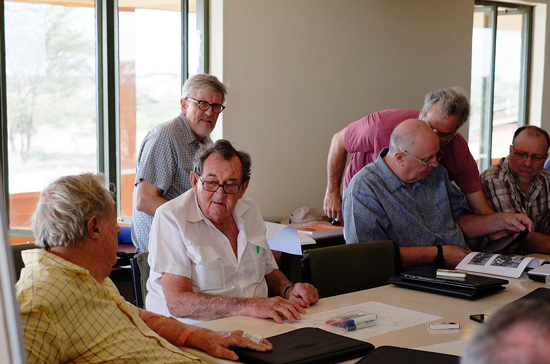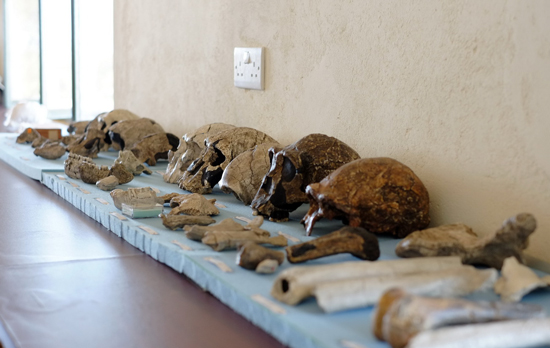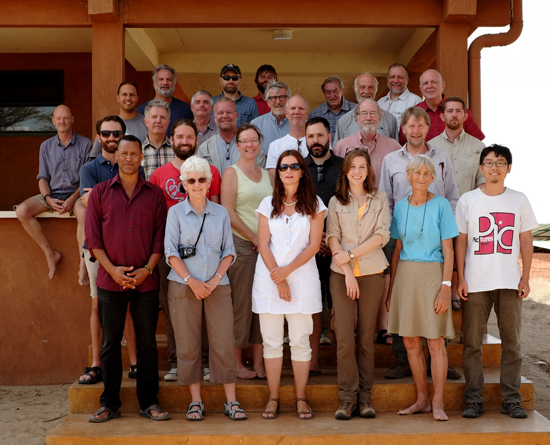The twelfth annual Stony Brook Human Evolution Workshop was held at the Turkana Basin Institute’s (TBI) Turkwel research facility, between August 5-9th, 2014. The workshop was organized to mark the 50th Anniversary of the publication by Louis Leakey, Phillip Tobias and John Napier of the paper that established Homo habilis as a taxon (Leakey, L. S. B, Tobias, P. V., & Napier, J. R. ,1964, A new species of the genus Homo from Olduvai Gorge, Nature, 202, 7–9).
The topics covered in the workshop included the discovery of Homo habilis, a review of the fossils that have been attributed to this and other early Homo taxa, the main morphological characteristics used in the diagnosis of these taxa, what fossils should be assigned to them, and the role diet, behaviour and ecology played in any taxonomic diversity observed.
In addition to the participants listed below, Jonathan Leakey, who in 1960 discovered the type specimen in an excavation of the locality that had yielded the skull of a large sabre-tooth carnivore, described what he could recall of the circumstances of the discovery.

From far left: Dr Richard Leakey, Jonathan Leakey Bernard Wood (behind), Bill Jungers, Bill Kimbel, Mike Plavcan.
Participants were drawn from a wide range of scientists in different disciplines. In addition to Richard Leakey (TBI/Stony Brook University) and the co-chairs, Bernard Wood (George Washington University) and William Jungers (Stony Brook University), the participants were Sergio Almecija (Stony Brook University), Zeresenay Alemseged (California Academy of Sciences), Kay Behrensmeyer (Smithsonian Institution), Lee Berger (Wits University), Frank Brown (The University of Utah), Christopher Dean (University College London), Mikael Fortelius (University of Helsinki), Fred Grine (Stony Brook University), Sonia Harmand (TBI), Bill Kimbel (Arizona State University), Meave Leakey (TBI/Stony Brook University), Jason Lewis (TBI), Lawrence Martin (Stony Brook University/TBI), Simon Neubauer (Max Planck Institute for Evolutionary Anthropology), Mike Plavcan (University of Arkansas), Philip Rightmire (Harvard University), Matt Sponheimer (University of Colorado, Boulder), Fred Spoor (Max Planck Institute for Evolutionary Anthropology/UCL), Carol Ward (University of Missouri, Columbia). The graduate students who attended were Carrie Mongle (Stony Brook University) Deming Yang (Stony Brook University) and David Patterson (George Washington University). Jamie Shreeve (National Geographic Society) acted as rapporteur.
The discussions centred on examining the three main claims made in the 1964 paper. The first was that the 1964 Homo habilis hypodigm provided evidence of a distinct species of early hominin. The second was that the new species shows evidence of sufficient departure (or in modern parlance a “grade shift”) from the morphology and inferred behaviors characteristic of what (for want of a better word) we will refer to as “archaic hominins’ (e.g., Australopithecus, Paranthropus, Kenyanthropus, etc.). The third claim was that enough of those departures were in the direction of later Homo to justify including the new taxon in that genus.
The covered during the workshop included:
History and background to the discovery of Homo habilis.
The morphology and anatomy of the fossils attributed to Homo habilis, including the cranial, dentition and post-cranial features.
Relevant early hominin discoveries from other sites in Africa and beyond.
Diet, ecology and behaviour of early Homo as see through the lenses of archaeology, functional morphology and stable isotopes.







